Abstract
What are the effects of Corona Virus Disease 19 (COVID-19) on inflation, unemployment, and GDP in Africa? Using geo-coded cross-sectional data taken from the World Health Organization and International Monetary Fund, we investigate the spatial distribution of COVID-19 and its effects on inflation, unemployment, and Gross Domestic Product (GDP) in Africa by employing the Geographic Information System (GIS), multivariate analysis of covariance (MANCOVA), and spatial statistics. The entire dataset was analyzed using Stata, ArcGIS, and R software. The result shows (1) that there is evidence of a spatial pattern of COVID-19 cases and death rate clustering behavior in Africa, verifying the existence of spatial autocorrelation. The result also reveals (2) that COVID-19 has a negative effect on unemployment, inflation, and GDP in Africa. We confirmed that (3) temperature, rainfall, and humidity were statistically significantly associated with the spread of the COVID-19 pandemic in Africa. The comparison of the GDP of African countries before and after the pandemic shows (4) a large decrease in GDP, the highest in Seychelles (23 percent). The result of the study shows (5) that there has been a significant increase in inflation and unemployment rates in all countries since the outbreak of the pandemic as compared to the time before the outbreak. There is also evidence that (6) there is a significant relationship between death rate due to COVID-19 and population density; temperature with COVID-19 cases and death rate; and precipitation with death rate due to COVID-19. Therefore, respective governments and the international community need to pay attention to controlling/reducing the impact of COVID-19 on inflation, unemployment, and GDP, focusing on the indicated demographic and environmental variables.
1. Introduction
Study Background
In late 2019, a new virus called Corona virus was seen in China and spread alarmingly to different parts of the world [1]. It was declared a novel virus, COVID-19, and characterized as a pandemic in early 2020 [2].
The global economy has been largely affected by the spread of the pandemic. Thus, clearly examining its relationship with different factors has been the interest of many researchers. It was well noted that temperature [3,4], humidity [5], sunshine hour [6], precipitation [7], wind condition [8], air quality [9,10], and population density [11,12] are regarded as the most driving factors for the spread of the pandemic. The 2021 World Economic Outlook from the International Monetary Fund (IMF) shows that global economic growth fell to an annualized rate of around −3.2% in 2020, with a recovery rate of 5.9% projected for 2021 and 4.9% for 2022.
The report by [13] revealed that in Sub-Saharan African countries, the global shock was projected to contract economic activity by 2.8% in 2020 from 2.2% in 2019. Similarly, it was noted that the massive spread of the pandemic varied from continent to continent [14,15,16]. Moreover, the articles by [17] assessed the impacts of covariates on COVID-19, while [18] addressed the prediction of COVID-19 in Africa; however, they lacked an impact assessment related to the economy. According to a report by the World Bank in 2017, Sub-Saharan Africa paid 5.17% of its total GDP for health, which is smaller than the 9.89% contributed by the Organization for Economic Co-operation and Development. This indicates that the amount of money contributed to the health care system was not enough to address the pandemic [19].
The spatial distribution of COVID-19 varies across the globe, including in Africa. On February 14, the first case of COVID-19 was reported in Africa, while the first South African case was confirmed on March 5, 2020 [20]. Following this, the pandemic has spread rapidly across the entire African continent. To mitigate its spread by paying attention to the hotspot areas, it is believed that the Geographic Information System (GIS) provides an excellent medium for integrating specific health data and economic data, along with its understanding of population habits, including healthcare services, and the environment [21]. Understanding disease space and time dynamics is important for both planners and epidemiologists, as with space distribution, the hot spot areas are marked for intervention [22]. Thus, clearly determining the spatial distribution of the pandemic and its impact, along with employment and inflation on the GDP, is important for hotspot area identification and further intervention.
A considerable number of articles have been published based on GIS and spatial modeling since the outbreak of the pandemic. For instance, [23] presented how various GIS applications are taken into consideration to model the driving factors of the pandemic, but it gives less emphasis to its impact on the economy. Spatial models are the most widely used tools to link the geographic relationship between several predictor parameters associated with the outbreak of any pandemic [24,25]. Moreover, GIS and spatial autoregressive models were the most popular techniques to describe the dispersion of COVID-19 by incorporating the issues of spatial dependency while considering population density, level of healthcare services, and environmental variables [26].
This work focuses on the spatial distribution of COVID-19 and tries to identify the effect of COVID-19 on inflation, unemployment, and GDP in Africa, along with the driving forces of the pandemic. It also examines the effect of the pandemic on three dominant economic indicators, namely inflation, unemployment rate, and GDP per capita, and suggests ways of reducing the impact of the pandemic and actions to be taken for further intervention. In short, this paper is aimed at assessing COVID-19 and examining its effect on inflation, unemployment rate, and Gross Domestic Product (GDP) in Africa via GIS and spatial exploratory techniques.
2. Data Source and Methodology
2.1. Study Area and Period
Africa is regarded as the second-largest and most populous continent after Asia. The continent has a land area of about 30.3 million km2, including adjacent islands; it covers 6% of Earth’s total surface area and 20% of its land area. Africa’s population was about 1.3 billion in 2018, which accounts for about 16% of the world’s human population. The size of the population is estimated to be 1.4 billion in 2022 (16.7% of the world’s population). The map of the study area is presented in Figure 1. A total of 54 African countries were considered for the study.
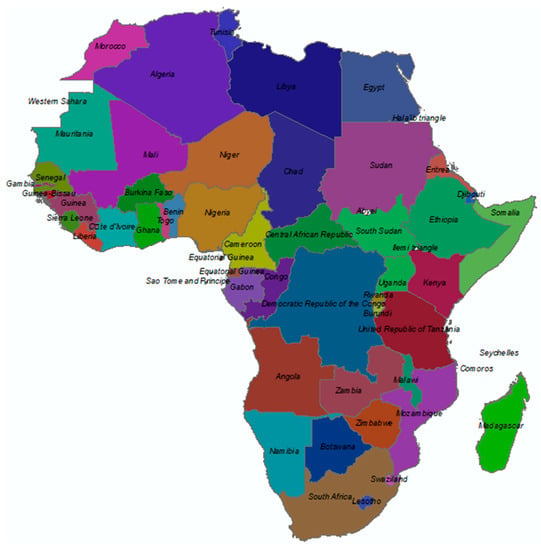
Figure 1.
The map of 54 African countries.
2.2. The Data
Invoked with the initiation of the current impact of cross-cutting issues, such as the outbreak of the pandemic, war, and inflation, including the unemployment rate, global datasets are taken into consideration. Four global datasets were considered: COVID-19 cases and deaths from the World Health Organization: GDP per capita from the International Monetary Fund; inflation taken from the different global databases; and unemployment rate directly taken from the World Bank, referring to the unemployment data that is based on the total labor force in line with the proposed objectives. The entire dataset that inspired this study was secondary data collected directly from the four datasets indicated above. The data were compiled from the World Health Organization’s reports up to 1 January 2021, since the outbreak of the pandemic. This data set contains the number of COVID-19 cases, deaths, and recoveries for all African countries. Moreover, the data for climate and other parameters were collected from online meteorology. The data on population density and GDP were taken from Richest African Countries 2022 (World Population Review, 2022). ArcGIS 10.4.1 was used for mapping the spatial distribution of COVID-19 and GDP per capita.
2.3. Variable Identification
The outcome variable in the study is the gross domestic product (GDP), measured in billions of US dollars.
The predictor variables considered in this study are summarized in Table 1.

Table 1.
Summary of the predictor variables.
2.4. Spatial Statistical Analysis
In this study, the methods of statistical analysis used include descriptive statistics, spatial autocorrelation analysis, and a spatial autoregressive model. Following the analysis, the model adequacy checks (diagnostics) for fitted models were examined.
2.4.1. Concept of Spatial Autocorrelation/Dependence
The primary premise underlying the analysis of spatial data is that values of a variable in close proximity are more similar or related than values in distant locations.
Tobler’s first law of geography summarizes this inverse relationship between value association and distance: “Everything is related to everything else, but near things are more related than distant things” [27]. When close-by observations (i.e., those in the same place) have similar variable values, the pattern is said to have positive spatial autocorrelation (self-correlation). In contrast to Tobler’s law, negative spatial autocorrelation is stated to exist when observations that are close in space are more dissimilar in variable values than observations that are further apart. When variable values are independent of location, zero autocorrelation exists.
According to [27], spatial autocorrelation can be loosely defined as the coincidence of value similarity with location similarity. In other words, high or low values for a random variable tend to cluster in space (positive spatial autocorrelation), or locations tend to be surrounded by neighbors with very dissimilar values (negative spatial autocorrelation). Of the two types of spatial autocorrelation, researchers usually focus on positive autocorrelation. Negative spatial autocorrelation implies a checkerboard pattern of values and does not always have a meaningful substantive interpretation [28]. The spatial autocorrelation/dependence is the situation where the dependent variable (the error terms) at each location is correlated to the observation in the dependent variable (the error term) of the other location [29,30,31,32].
2.4.2. Methods of Measuring Spatial Autocorrelation
Contiguity Spatial Weight Matrix
According to Tobler’s first law, the neighboring or nearest regions are coded in the form of a spatial weight matrix with zero diagonal and non-zero off-diagonal elements, which often weigh to sum to unity in each row with typical elements. The non-standardized weight matrix is stated as:
The standardized weight matrix, which incorporates the average weight value, can be written as follows:
where are elements of the non-standardized weight matrix along location and location and is the ith row total of the non-standardized weight matrix; is the number of locations considered.
2.4.3. Test of Global and Local Spatial Autocorrelation
Spatial autocorrelation is an important concept in spatial statistics, and it is used to measure similarity between nearby observations. The test for spatial autocorrelation is designed to quantify the extent of clustering and allow for statistical inference. The null hypothesis (under the normality and independence assumptions) is given by:
H0.
There is no spatial autocorrelation ()
Against the alternative hypothesis of spatial dependence/autocorrelation () which is the claim of interest. To test this hypothesis, we have used Moran’s I and Geary’s C analyses.
Moran’s I Correlation Analysis
Moran’s I correlation coefficient is widely used to identify the spatial association pattern. To compute the spatial autocorrelation of the death rate and confirmed cases due to COVID-19, Moran’s I correlation was employed. The values of Global Mora’s I lie in the interval of −1 and 1. If the value is significantly less than 0, then there is a negative spatial relationship; if it is greater than zero, there is a positive spatial relationship; and if it is zero, there is no spatial relationship. Local Moran’s I was used to identify the local spatial pattern and outliers among the death rate and confirmed cases due to COVID-19 in all African countries. This analysis was conducted using ArcGIS version 10.4 and GeoDa. The global Moran’s I is given as follow:
where is global Moran’s I correlation coefficient; and respectively represent either the death rate or confirmed cases due to COVID-19 of site and site ; is the mean of y; n is the number of locations (countries); and is the spatial weights between site and site .
Moran Scatter Plot
The Moran scatter plot is a useful visual tool that enables us to assess how similar an observed value is to its neighboring observations. It is used to show the linear correlation between the dependent (outcome) variable (Y) and the corresponding neighboring dependent variable (WY). Specifically, WY is plotted against Y, and the Moran’s I coefficient is the slope of the regression curve [27].
The four different quadrants of the scatter plot correspond to the four types of local spatial association between a region (country) and its neighbors: the first quadrant (HH) is a region with a high value surrounded by regions with high values (top on the right); the second (LH) is a region with a low value surrounded by regions with high values (top on the left); the third (LL) is a region with a low value surrounded by regions with low values (bottom on the left); and the last (HL) is a region with a high value surrounded by regions with low values (bottom on the right). The first and third quadrants refer to positive spatial autocorrelation, indicating spatial clustering of similar values, whereas the second and fourth quadrants represent negative spatial autocorrelation, indicating spatial clustering of dissimilar values.
2.5. Spatial Statistical Methods of Analysis
Spatial exploratory analysis, mainly the Moran scatter plot test of spatial autocorrelation by incorporating the spatial weight matrix, was employed to examine the issue of spatial autocorrelation [28,33,34,35,36,37]. The model used to describe the outcome variable is described in Section 2.3. The effect of the climatic factors on COVID-19 was tested with the help of the Multivariate Analysis of Covariance (MANCOVA). Finally, the spatial autoregressive model is taken into consideration.
3. Results and Discussion
3.1. Descriptive Results
The African economy had been progressing prior to the outbreak of the pandemic. However, according to the recent report by the African Economic Outlook (2022), about 30 million people in Africa were pushed into extreme poverty in 2021, and about 22 million jobs were lost in the same year because of the pandemic. It was projected that the trend would continue, for various reasons, through the second half of 2022 and on into 2023. Thus, assessing COVID-19, inflation, and unemployment and their impacts on Gross Domestic Product (GDP) in Africa is highly recommended and advisable. This section mainly focuses on descriptive results and discussions based on the global datasets.
Table 2 presents a summary of descriptive measures on gross domestic product in billions of dollars, death rate per 1000 people, and COVID-19 cases for all 54 African countries. The data were obtained from the WHO and the International Monetary Fund.

Table 2.
Summary of descriptive measures.
3.2. The Top Seven African Countries Affected by COVID-19
Based on the data, it was noted that Angola, Algeria, Egypt, South Africa, Kenya, Tunisia, and Seychelles were regarded as the top seven countries with a high number of COVID-19 cases. Among these, South Africa is the country with the highest number of COVID-19 cases (Figure 2).
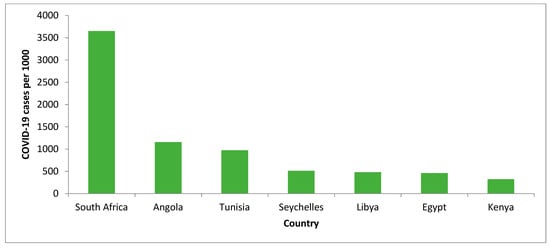
Figure 2.
Hotspot has confirmed cases of COVID-19 in Africa.
To examine the effect of COVID-19 on GDP per capita, the top seven African countries with high COVID-19 cases and deaths were taken into consideration. Figure 3 indicates the magnitude of GDP per capita before the pandemic (2019) and during the pandemic (2021), where the axis denotes the name of the countries (Angola, Algeria, Egypt, Kenya, Tunisia, South Africa, and Seychelles), and the axis indicates the GDP per capita in US dollars. It can be seen that the GDP per capita has decreased during the pandemic as compared to the GDP per capita before the outbreak of the pandemic in all countries except Egypt. The increase in Egypt’s GDP is largely accounted for by the fact that during the pandemic, a large amount of money was allocated to control and prevent COVID-19 and the government’s swift and prudent policy response, coupled with significant IMF support. Moreover, the country has experienced fewer movement restrictions and implemented a Preparedness and Response Plan (CPRP) (United Nations Egypt, 2020). The result based on the mean difference of the paired sample t test confirms a significant mean difference in GDP before and after the outbreak of the pandemic (Figure 3).
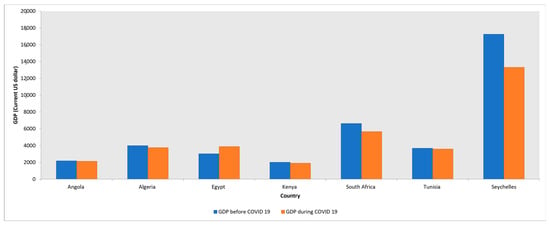
Figure 3.
GDP per capita before and after the outbreak of COVID-19 in seven African countries.
As indicated in Table 3, the GDP per capita of Angola decreased from 2177.8 to 2137.9 (1.8%) dollars, Algeria from 3989.7 to 3765.0 (5.6%) dollars, Kenya’s GDP per capita decreased from 2006.8 to 1909.3 (4.9%) dollars, and South Africa’s GDP per capita decreased from 6624.8 to 5655.9 (14.6%) dollars.

Table 3.
Summary of GDP per capita before and during COVID-19.
3.3. Death Rate and GDP before and after the Outbreak
Figure 4 displays the GDP of African countries. The figure shows that Nigeria’s GDP is the largest (504 billion dollars), while Sao Tome and Principe’s is the smallest (0.5 billion). The average GDP for 54 African countries is 62.78 billion USD.
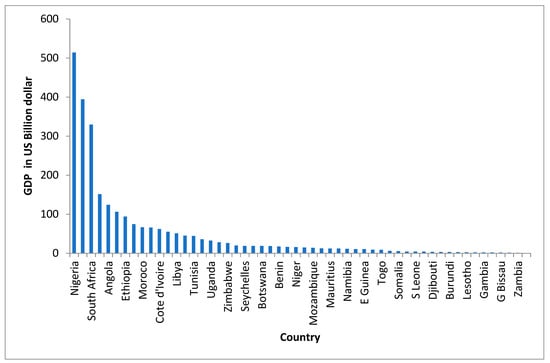
Figure 4.
GDP in billions of USD by country in Africa.
Figure 5 depicts the number of COVID-19 cases per 1000 people by country. It shows that South Africa experienced the highest number of cases (3648.968 per 1000 people), followed by Tunisia (974.214 per 1000 people).
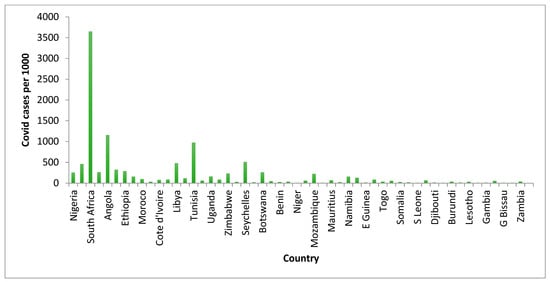
Figure 5.
COVID-19 cases per 1000 people in Africa.
Figure 6 depicts the death rates due to COVID-19 for selected countries, from which we can clearly observe the variation in the spatial distribution of the death rates. The result shows that South Africa, Angola, Tunisia, and Ethiopia have experienced high death rates due to the pandemic in Africa.
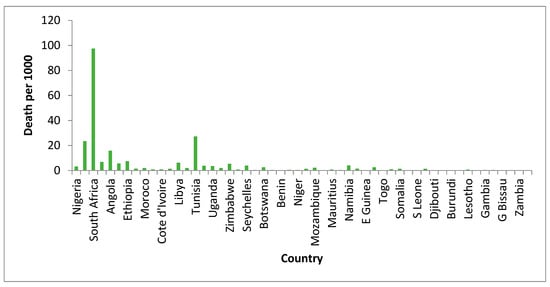
Figure 6.
The spatial distribution of deaths due to COVID-19 per 1000 people.
3.4. Testing for Spatial Autocorrelation
The Moran’s I coefficient, one of the most extensively used measures of spatial autocorrelation, was utilized to identify the spatial patterns. Tests and presentations of the global Moran’s I and local Moran’s I statistics for clustering are included in the spatial autocorrelation analysis package. The Moran scatter plot is used to show the global test, in which the slope of the regression line corresponds to Moran’s I. At a significance level of 0.05, the non-existence of significant clustering of the death rate and confirmed cases due to COVID-19 was tested in selected countries. First, we calculated the global Moran’s I test statistics. Furthermore, to ensure that the results were consistent, a diagnostic test for spatial dependence was conducted.
3.4.1. Tests of Spatial Autocorrelation Using Global Moran’s I
The spatial distribution of COVID-19 cases and the death rate in Africa can be critically examined using the global spatial autocorrelation. Our goal here is to test the null hypothesis (under the normality and independence assumptions) of “there is no spatial autocorrelation ()” against the alternative hypothesis of “spatial dependence/autocorrelation )”. The result of global Moran’s I shows that there is a positive spatial autocorrelation for the confirmed cases of COVID-19 (, ) and death rate (, ) at the 5% level of significance. The result corresponding to the global test of spatial autocorrelation is given in Table 4.

Table 4.
The results of the global Moran’s I correlation coefficient.
Based on the -values of the provided Moran’s I coefficients, the global tests of spatial autocorrelation suggest the rejection of the null hypothesis of no spatial autocorrelation of the two spatial components at the 5% level of significance. The Moran’s I coefficients of the confirmed cases and death rate show that the death rate due to COVID-19 and confirmed cases have substantial positive spatial autocorrelation or clustering. Under the assumption of normality, we utilize Moran’s scatter plot to depict global spatial autocorrelation, as shown in Figure 7a,b.
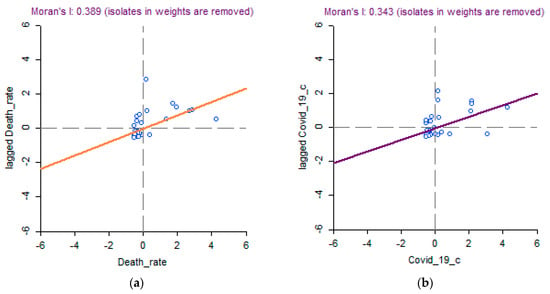
Figure 7.
The Moran scatter plot of the spatial distribution of confirmed cases and death rate. The result shown in both (a,b) show that there is spatial dependence two locations based on the data of death rate and number of confirmed cases of COVID 19. The values of the Moran’s I reveals that there is positive spatial autocorrelation confirming the existance of the spatial autocorrelation on both events.
Figure 8a presents the spatial distribution of the percentage decrease in GDP per capita by comparing the values of GDP before and after the pandemic in African countries. It can be observed that in countries where there are fewer COVID-19 cases, the percentage decrease in GDP per capita in USD is low. On the contrary, in countries where there are high COVID-19 cases, the percentage decrease in GDP per capita in USD is high. Our results are similar to those of the study conducted by [38]. Following the result corresponding to the spatial distribution of GDP in Africa, the geospatial result corresponding to the COVID-19 cases and death rate in Africa is visualized in Figure 8b,c, from which we note that South Africa was the most highly affected country compared to the other African countries.
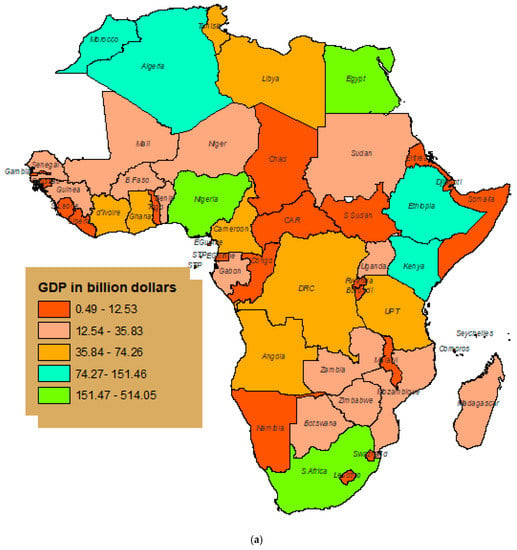
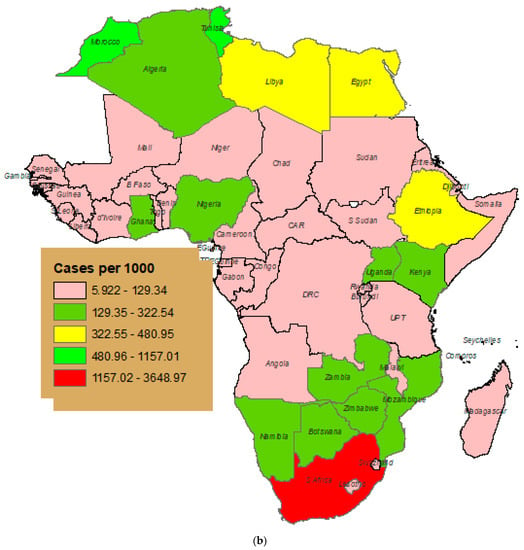
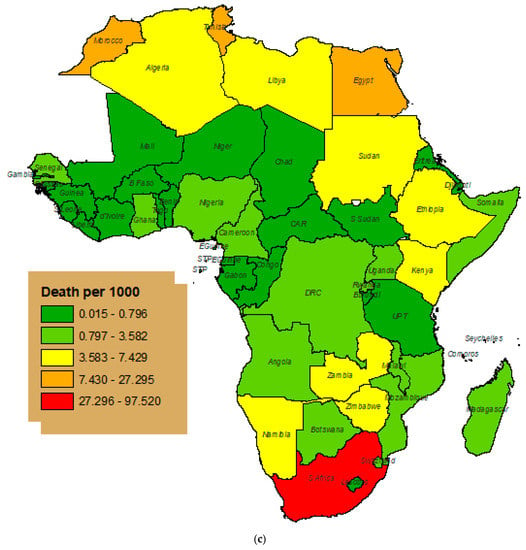
Figure 8.
GDP per capita distribution (a), hotspot areas of confirmed cases (b), and deaths due to COVID-19 per 1000 people (c).
3.4.2. Result of Multivariate Analysis of Covariance Methods
To determine the relationship between several predictor variables and the confirmed cases and death rate due to the pandemic, we also conducted a multivariate analysis of covariance and obtained the results presented in Table 5.

Table 5.
Effect of predictor variables on COVID-19 in Africa.
The result of multivariate analysis of covariance shows that death rate due to COVID-19 with population density, temperature with COVID-19 cases and death rate, precipitation with death rate due to COVID-19, and wind with death rate due to COVID-19 have a significant association at the 5% level of significance (see Table 5).
3.4.3. Inflation and Unemployment Rate (before and during COVID-19)
This subsection addresses the level of inflation before and during the outbreak of COVID-19 in Africa. The study also explored the effect of COVID-19 on the unemployment rate based on the data taken from the employment and total labor force reports from the World Bank. Figure 9 shows the inflation after the outbreak of the pandemic as compared with the inflation before the outbreak of the pandemic in each country, from which we note that there has been a significant increment in inflation since the outbreak of the pandemic. We considered the consumer price index before the outbreak of the pandemic and the consumer price index of 2020 and 2021 during the pandemic for each country. As depicted in Figure 9, the inflation after the outbreak of COVID-19 for each country is high as compared to the inflation before the outbreak of the pandemic. The result reveals that there is a marked difference in inflation before and after the outbreak of the pandemic in all countries (Figure 9).
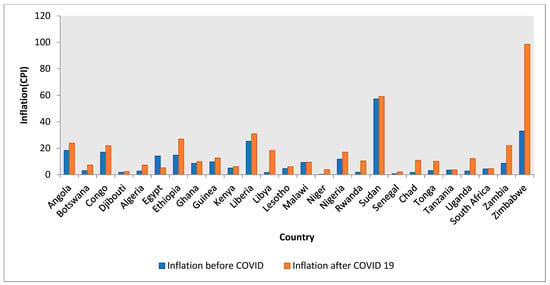
Figure 9.
Inflation before and during COVID-19.
Table 6 shows the inflation before and after the outbreak of COVID-19 in Africa. The result clearly shows a marked difference in inflation before and after the outbreak of the pandemic in Africa.

Table 6.
Inflation before and during COVID-19 in Africa.
Table 7 confirms the existence of a significant mean difference in inflation before and during the outbreak of the pandemic in Africa.

Table 7.
Paired sample test: Inflation before and during COVID-19 in Africa.
The result of the study also showed that inflation during COVID-19 was extremely high and has indirectly influenced the GDP per capita in African countries. Similarly, the unemployment rate during the pandemic has also increased considerably in African countries, ranging from a minimum of 0.6875 in Niger to a maximum of 31.3895 in South Africa (Figure 10).
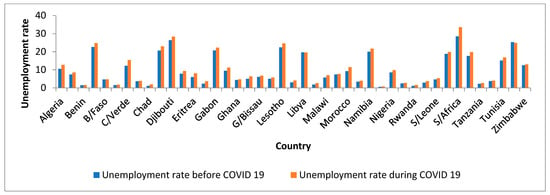
Figure 10.
Unemployment rate before and during the pandemic.
3.5. Result of Spatial Autoregressive Modeling
The analysis using a spatial autoregressive model focused on the relationship between confirmed cases, death per 1000 people due to COVID-19, and inflation on the one hand and GDP per capita on the other. The result shows that as inflation increases, the GDP per capita decreases consistently across African countries. Similarly, as confirmed cases and deaths due to COVID-19 increase, GDP per capita declines across the countries.
Several researchers have studied the benefits of environmental, social, and governance (ESG) performance. For instance, Ref. [39] has assessed the importance of good ESG performance for GDP per capita and suggested the existence of a positive relationship between ESG and GDP in terms of per capita over the long term. Therefore, a decrease in GDP per capita is somehow related to inefficient ESG performance. This indicates that in order to bring about sustainable economic recovery in the post-COVID-19 era, there is a need for coordinated efforts to improve the performance of ESG in African countries, focusing on areas, such as investment in renewable energy, promoting sustainable business practices, and supporting local communities.
4. Conclusions
In this research article, we assessed the effects of COVID-19 on inflation, unemployment rate, and GDP per capita in Africa via GIS and spatial statistics. Measures of spatial autocorrelation, including Moran’s I and Moran scatter plots, were employed to visualize the spatial distribution of the three parameters (GDP, death per 1000 people due to COVID-19, and COVID-19 cases per 1000 people). The resuts indicate that the spatial distribution of the pandemic is clustered, justifying the existence of spatial autocorrelation. The result of the study also shows a decrease in GDP per capita during the pandemic, and the rate of decrease varies from country to country, confirming the existence of spatial dependency. A significantly high death rate and a high confirmed number of cases of COVID-19 were related to a low GDP per capita. The result of multivariate analysis of covariance shows that there is a significant association between death rate due to COVID-19 and population density, temperature with COVID-19 cases, precipitation with death rate due to COVID-19, and wind with death rate due to COVID-19 at a 5% level of significance. There is also evidence of a significant difference between the consumer price index (inflation rate) and unemployment rate registered before and after the outbreak of the pandemic. A marked increase in inflation and unemployment rates has been observed since the outbreak of COVID-19. Reducing unemployment and boosting the GDP per capita can boost the performance of the ESG. The study suggests the need to support African countries in reducing/controlling the impact of COVID-19 on inflation, unemployment, and GDP per capita.
Author Contributions
The corresponding author (H.T.) designed the manuscript, wrote the whole manuscript, and conducted the analysis. The author, B.G., edited and revised the entire work. All authors have read and agreed to the published version of the manuscript.
Funding
This research received no external funding.
Institutional Review Board Statement
We declare that this work is very ethical and has no problems related to the issue of ethics. The authors are authorized to download data from the IMF and WHO. The data is publicly available and has no personal identifiers.
Informed Consent Statement
Not applicable.
Data Availability Statement
The data presented in this study are available on request from the corresponding author.
Acknowledgments
The authors would like to thank the IMF and WHO for providing the data for the study.
Conflicts of Interest
The authors declare no conflict of interest.
References
- Singh, K.; Agarwal, A. Impact of weather indicators on the COVID-19 outbreak: A Multi-state study in India. medRxiv 2020, 2020-06. [Google Scholar] [CrossRef]
- WHO. Naming the Coronavirus Disease (COVID-19) and the Virus That Causes It. 2019. Available online: https://www.who.int/emergencies/diseases/novelcoronavirus-2019/technical-guidance/naming-the-coronavirus-disease-(covid-2019)-and-the-virus-that-causes-it (accessed on 10 May 2023).
- Gupta, A.; Banerjee, S.; Das, S. Significance of geographical factors to the COVID-19 outbreak in India. Model. Earth Syst. Environ. 2020, 6, 2645–2653. [Google Scholar] [CrossRef] [PubMed]
- To, T.; Zhang, K.; Maguire, B.; Terebessy, E.; Fong, I.; Parikh, S.; Zhu, J. Correlation of Ambient temperature and COVID-19 incidence in Canada. Sci. Total Environ. 2020, 750, 141484. [Google Scholar] [CrossRef] [PubMed]
- Rashed, E.A.; Kodera, S.; Gomez-Tames, J.; Hirata, A. Influence of absolute humidity, temperature and population density on COVID-19 spread and decay durations: Multi-prefecture study in Japan. Int. J. Environ. Res. Public Health 2020, 17, 5354. [Google Scholar] [CrossRef]
- Azuma, K.; Kagi, N.; Kim, H.; Hayashi, M. Impact of climate and ambient air pollution on the epidemic growth during COVID-19 outbreak in Japan. Environ. Res. 2020, 190, 110042. [Google Scholar] [CrossRef]
- Menebo, M.M. Temperature and precipitation associate with COVID-19 new daily cases: A correlation study between weather and COVID-19 pandemic in Oslo, Norway. Sci. Total. Environ. 2020, 737, 139659. [Google Scholar] [CrossRef]
- Rendana, M. Impact of the wind conditions on COVID-19 pandemic: A new insight for direction of the spread of the virus. Urban Clim. 2020, 34, 100680. [Google Scholar] [CrossRef]
- Suhaimi, N.F.; Jalaludin, J.; Latif, M.T. Demystifying a possible relationship between COVID-19, air quality and meteorological factors: Evidence from Kuala Lumpur, Malaysia. Aerosol Air Qual. Res. 2020, 20, 1520–1529. [Google Scholar] [CrossRef]
- Wong, D.W.; Li, Y. Spreading of COVID-19: Density matters. PLoS ONE 2020, 15, e0242398. [Google Scholar] [CrossRef]
- Bhadra, A.; Mukherjee, A.; Sarkar, K. Impact of population density on COVID-19 infected and mortality rate in India. Model. Earth Syst. Environ. 2021, 7, 623–629. [Google Scholar] [CrossRef]
- Sun, Z.; Zhang, H.; Yang, Y.; Wan, H.; Wang, Y. Impacts of geographic factors and population density on the COVID-19 spreading under the lockdown policies of China. Sci. Total Environ. 2020, 746, 141347. [Google Scholar] [CrossRef] [PubMed]
- World Bank. Available online: https://data.worldbank.org/indicator/SH.XPD.CHEX.GD.ZS?Contextual=max&end=2017&locations=ZG-1W&start=2000 (accessed on 30 May 2020).
- Rodriguez-Morales, A.J.; Bonilla-Aldana, D.K.; Balbin-Ramon, G.J.; Rabaan, A.; Sah, R.; Paniz-Mondolfi, A.; Pagliano, P.; Esposito, S. History is repeating itself, a probable zoonotic spillover as a cause of an epidemic: The case of 2019 novel Coronavirus. Infez Med. 2020, 28, 3–5. [Google Scholar] [PubMed]
- Martellucci, C.A.; Sah, R.; Rabaan, A.A.; Dhama, K.; Casalone, C.; Arteaga-Livias, K.; Sawano, T.; Ozaki, A.; Bhandari, D.; Higuchi, A.; et al. Changes in the spatial distribution of COVID-19 incidence in Italy using GIS-based maps. Ann. Clin. Microbiol. Antimicrob. 2021, 19, 30. [Google Scholar] [CrossRef]
- Rodriguez-Morales, A.J.; MacGregor, K.; Kanagarajah, S.; Patel, D.; Schlagen-hauf, P. Going global—Travel and the 2019 novel coronavirus. Travel Med. Infect. Dis. 2020, 33, 101578. [Google Scholar] [CrossRef] [PubMed]
- Habte Tadesse Likassa. The impacts of covariates on spatial distribution of corona virus 2019 (COVID-19): What do the data show through ANCOVA and MANCOVA. EJMO 2020, 4, 141–148. [Google Scholar]
- Likassa, H.T.; Xain, W.; Tang, X.; Gobebo, G. Predictive models on COVID-19: What Africans should do? Infect. Dis. Model. 2021, 6, 302–312. [Google Scholar] [CrossRef]
- Nuwagira, E.; Muzoora, C. Is Sub-Saharan Africa prepared for COVID-19? Trop. Med. Health 2020, 48, 18. [Google Scholar] [CrossRef]
- Czernin, J.; Fanti, S.; Meyer, P.T.; Allen-Auerbach, M.; Hacker, M.; Sathekge, M.; Hicks, R.; Scott, A.M.; Hatazawa, J.; Yun, M.; et al. Imaging clinic operations in the times of COVID-19: Strategies, Precautions and Experiences. J. Nucl. Med. 2020, 61, 1–5. [Google Scholar] [CrossRef]
- Wang, Y.J.; Zhang, N.; Lv, H.L.; Zhou, Y.B. Preliminary Analysis on the Incidence Trend of Novel Coronavirus Pneumonia in Shanghai. Search.Bvsalud.Org. Available online: https://search.bvsalud.org/global-literature-on-novel-coronavirus2019-ncov/resource/en/covidwho-6040 (accessed on 10 May 2023).
- Snow, J. On the Mode of Communication of Cholera. 1855. Available online: http://www.ph.ucla.edu/epi/snow/snowbook.html (accessed on 10 May 2023).
- Boulos, M.N.K.; Geraghty, E.M. Geographical tracking and mapping of coronavirus disease COVID-19/severe acute respiratory syndrome coronavirus 2 (SARSCoV-2) epidemic and associated events around the world: How 21st century GIS technologies are supporting the global fight against outbreaks and epidemics. Int. J. Health Geogr. 2020, 19, 8. [Google Scholar]
- Mollalo, A.; Khodabandehloo, E. Zoonotic cutaneous leishmaniasis in northeastern Iran: A GIS-based spatio-temporal multi-criteria decision-making approach. Epidemiol. Infect. 2016, 144, 2217–2229. [Google Scholar] [CrossRef]
- Mollalo, A.; Alimohammadi, A.; Shirzadi, M.R.; Malek, M.R. Geographic information system-based analysis of the spatial and spatio-temporal distribution of zoonotic cutaneous leishmaniasis in Golestan Province, north-east of Iran. Zoonoses Public Health 2015, 62, 18–28. [Google Scholar] [CrossRef] [PubMed]
- Han, J.; Yin, J.; Wu, X.; Wang, D.; Li, C. Environment and COVID-19 incidence: A critical review. J. Environ. Sci. 2023, 124, 933–951. [Google Scholar] [CrossRef] [PubMed]
- Zhang, Y.; Rashid, A.; Guo, S.; Jing, Y.; Zeng, Q.; Li, Y.; Adyari, B.; Yang, J.; Tang, L.; Yu, C.P.; et al. Spatial autocorrelation and temporal variation of contaminants of emerging concern in a typical Spatial autocorrelation and temporal variation of contaminants of emerging concern in a typical urbanizing river. Water Res. 2022, 212, 118–120. [Google Scholar] [CrossRef] [PubMed]
- Anselin, L. Model Validation in Spatial Econometrics: A Review and Evaluation of Alternative Approaches. Int. Reg. Sci. Rev. 1988, 11, 279–316. [Google Scholar] [CrossRef]
- Cressie, N.A.C. Statistics for spatial data. In Wiley Series in Probability and Mathematical Statistics: Applied Probability and Statistics; John Wiley & Sons: Hoboken, NJ, USA, 1993. [Google Scholar]
- International Monetary Fund. World Economic Outlook Update; International Monetary Fund: Washington, DC, USA, 2021; p. 6. [Google Scholar]
- United Nations. Egypt COVID-19 Response and Recovery Interventions of the United Nations in Egypt; United Nations: Cairo, Egypt, 2020. [Google Scholar]
- Schober, P.; Boer, C.; Schwarte, L.A. Correlation coefficients: Appropriate use and interpretation. Anesth. Analg. 2018, 126, 1763–1768. [Google Scholar] [CrossRef]
- Anselin, L.; Le Gallo, J.; Jayet, H. Spatial Panel Econometrics. In The Econometrics of Panel Data: Fundamentals and Recent Developments in Theory and Practice; Mátyás, L., Sevestre, P., Eds.; Springer: Berlin/Heidelberg, Germany, 2008; pp. 625–660. [Google Scholar] [CrossRef]
- Anselin, L. Spatial econometrics. In Handbook of Spatial Analysis in the Social Sciences; Edward Elgar Publishing: Cheltenham, UK, 2022; pp. 101–122. [Google Scholar]
- Anselin, L. Spatial Econometrics: Methods and Models; Springer: New York, NY, USA, 1988. [Google Scholar]
- Anselin, L. The Moran Scatter Plot as an Exploratory Spatial Data Analysis Tool to Assess Local Instability in Spatial Association; Taylor & Francis Group: Oxford, NY, USA, 1996; pp. 111–125. [Google Scholar]
- Anselin, L. Lagrange Multiplier Test Diagnostics for Spatial Dependence and Spatial Heterogeneity. Geogr. Anal. 1988, 20, 1–17. [Google Scholar] [CrossRef]
- Martellucci, C.A.; Flacco, M.E.; Cappadona, R.; Bravi, F.; Mantovani, L.; Manzoli, L. SARS-CoV-2 pandemic: An overview. Adv. Biol. Regul. 2020, 77, 100736. [Google Scholar] [CrossRef]
- Diaye, M.A.; Ho, S.H.; Oueghlissi, R. ESG performance and economic growth: A panel co-integration analysis. Empirica 2021, 49, 99–122. [Google Scholar] [CrossRef]
Disclaimer/Publisher’s Note: The statements, opinions and data contained in all publications are solely those of the individual author(s) and contributor(s) and not of MDPI and/or the editor(s). MDPI and/or the editor(s) disclaim responsibility for any injury to people or property resulting from any ideas, methods, instructions or products referred to in the content. |
© 2023 by the authors. Licensee MDPI, Basel, Switzerland. This article is an open access article distributed under the terms and conditions of the Creative Commons Attribution (CC BY) license (https://creativecommons.org/licenses/by/4.0/).